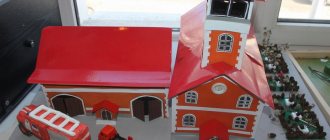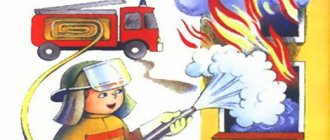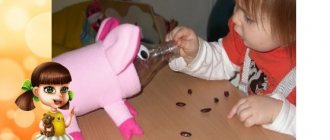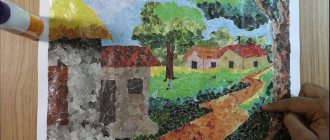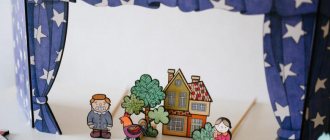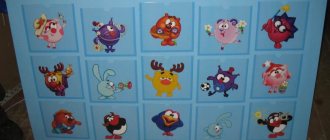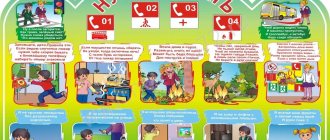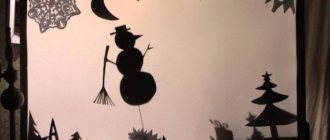Loving parents are ready to do anything for the comprehensive, and most importantly, comfortable and joyful development of their children. According to Maria Montessori's method of education, handmade materials are all a child needs to reach their full potential. It’s not difficult to make such toys, the main thing is to set a goal and devote 2-3 hours of your time. We have collected several master classes, more than 30 ideas, as well as examples of educational games based on the famous Italian teacher.
Didactic and educational games according to the Montessori system
Montessori games for children are built on the principle of complete independence. Children choose their own materials, pace and rhythms of play. If a child gets bored with one activity, he can change the environment and material at any time. The most important feature is considered to be the right to choose the direction in which the baby would like to develop.
The principle of the Montessori system
The task of parents and teachers is to create a large subject environment. All elements that a child can use to play must be accessible. Educators must respect choice. The goals of education are to create the most comfortable environment in which full development will take place. The child should act both as an observer and as an assistant, if necessary. You can’t strive to make your baby like you. Montessori believes that it is unacceptable to interfere with the process of personality development.
Note! The goals of an adult during a lesson using the Montessori method are to help the child in an effort to develop his independence, to give hints only at the moment when he asks for it. It is strictly forbidden to force a child to do anything.
What are they and what are they aimed at
In the process of developing her methodology, Maria Montessori spent a long time observing the behavior of children in play. Due to this, classes are divided into different areas:
- Mathematical, aimed at developing mental abilities.
- Language to develop communication and cognitive skills.
- Sensory, designed to develop senses of vivid perception of the environment.
- Exercises aimed at developing practical and everyday skills.
- Space so that a child can find his own place in this world.
The purpose of Montessori didactic games is to help children and their spiritual and mental development. The child needs to choose such didactic material on which he will fully concentrate. All aids should be kept as simple as possible, as adult intervention is not recommended. That is, conditions must be created for the child under which he will not only be able to find the mistake himself, but also correct it.
Principles of working with didactic material:
- All elements for games should be located at eye level. This will encourage the child to be active.
- Use of the material is possible only after the parent explains its purpose.
- The work should be carried out in stages, from simple techniques to more complex ones.
- A child can work with material not only according to the principle established by an adult. He can independently apply knowledge.
- It is important to teach your child that after completing each lesson, he himself returns the material to its place. Only after this can he begin another game.
- The elements are laid out in a certain order in front of the baby on a rug or table.
Note! If group classes are held, then one child should work with one material; there should be no transfer of elements from hand to hand to another participant.
Didactic elements
Features of the educational method
“Education is not so much the responsibility of the teacher as it is a natural process of child development. It does not occur due to his perception of the words of adults, but represents the accumulation of experience in practical actions, independent discoveries that he draws from the environment around him.”
Great words from the great woman Maria Montessori - scientist, doctor, teacher, philosopher and humanist. More than a century ago, she was able to teach her charges - mentally retarded children - so that they surpassed their healthy peers in reading, writing and counting. Her achievements shook the whole world and exposed the imperfections of traditional education. In 1907, Maria opened a school for healthy children in Rome. The methods she used in her work continue to be improved to this day.
Features of Montessori education:
- the use of didactic materials that will allow the child to study independently: study, practice actions, detect and correct errors;
- encouraging the freedom of the child, recognizing his right to indulge in whatever activity he likes, without time or any other restrictions;
- collective learning in a group of different ages, where the younger ones adopt the experience and knowledge of the older ones, and they, in turn, learn care and responsibility;
- lack of competition between children and any rating system;
- motivating, encouraging, facilitating role of the educator, but not limiting or prescriptive.
“Help me do it myself” is the main principle of the Montessori method. You can find out more about her here.
Sent for sorting
Games focused on the sorting principle are aimed at developing visual skills and help train other organs. As a game activity you can offer:
- Sorting items from 2 to 5 years old. It can be both in shape and color. The lesson develops attentiveness and logic. For the activity you need to take several sets of objects according to size, shape and color. Playing with buttons has a good effect on development. You need to take a large number of buttons, in which there will be five or six identical ones. Mix all the buttons in a bowl, then show your child which type to choose.
- An excellent activity for sensory development is wooden cubes of various sizes. You can buy cubes that are inserted into each other, like a nesting doll.
- A pyramid would be a good activity for children aged two years and older. It can be of any type, but the principle is the same. Such a toy should have one rod and a set of elements. The child's task is to find identical shapes, for example, circles.
- You can choose simple puzzles as a sorting game. In the Montessori method, wooden ones with beautiful pictures are selected. For children under four years old, you should choose puzzles in which each element has a handle to make it easy to hold. It is recommended to avoid cardboard frames.
Pyramid game
Freedom of the child and the role of the educator
By the role of a teacher we will understand not only employees of child care institutions, but also the child’s parents and other adults who decided to use this method.
Montessori invites the teacher to master the consciousness of a scientist. Take on a more specialized role as an observer of the child (like a scientist in a laboratory observing microorganisms through a microscope) rather than simply monitoring his safety and assigning tasks.
“I firmly believe that we should cultivate in our teachers the spirit of a scientist, and not instill in them the skills of mechanical work.”
The teacher's task is to meaningfully monitor the child. The teacher should not impose knowledge or purposefully teach the child. He can sometimes only slightly direct the child’s actions (without nevertheless allowing him to feel his presence). And he can help only at the request of the child himself.
"Wait and watch." This is the motto of the teacher. Let's wait and be always ready to share with the child his successes and difficulties. He himself will ask us for help, and then we will have to respond joyfully. Let us be patient as we watch his slow progress. And we will show joy and enthusiasm when the child wants to share his successes with us. If we could say, “We have respect and interest in the actions of our children, we treat them as we would like to be treated,” then we would certainly understand the great principle of education and would undoubtedly become a model good teachers."
The child himself is given the task of being free and doing whatever he wants in the environment, without disturbing other children. But even so, the teacher should not be a passive observer, but should be an active scientist:
“The freedom of the child must have a limitation, the criterion of which is the collective and its interests, and a form that is commonly called good upbringing. To do this, you need to study each child individually, finding out what in his behavior can cause offense and irritation to others, and what inclinations can subsequently lead to rude behavior. In all other respects - in all manifestations that have some benefit - whatever they may be and whatever form they are expressed in - everything should be allowed, but with mandatory supervision from the teacher.”
In such a free environment, the child learns and develops independently, through Montessori materials (parents call them “Montessori toys”), which contain self-learning functions.
The classic Montessori group consists of children from 2 years 8 months to 6 years. All children study in the same group, not separated by age. This is a good solution, since the younger ones learn from the older ones, take from them examples of behavior, actions with objects, etc.; and the elders learn to teach the younger ones, showing sensitivity and care, they take on the role of leader and mentor. This interaction helps establish a friendly atmosphere in the group.
Matching games
Matching games are the most popular Montessori activities for ages 1 to 3. The main types are:
- Activities with colors - you can offer your child a cardboard circle with multi-colored sectors and clothespins of the same shades. The child must independently choose his own clothespin for each sector.
- The game can be combined with the help of mom. For example, invite your child to sort washed socks into pairs.
How to teach your child mental math on your own
This group of classes develops logic and attention.
Games with colors
How to build classes at home
To achieve results, you need to create the right atmosphere. The first stage is zoning the space. Each zone is filled with so-called didactic material. At first glance, this may seem inconvenient, but this arrangement allows you to keep things in their designated place. As a result, this will help not only children to master the world, but also adults to maintain order.
Classes cannot be held only at certain times or force the child to do something he does not want. Children study when they want. An example of a standard situation when the system works is when a mother is cleaning the apartment, and the child goes to his practice corner, takes a broom or dustpan and helps. At first, you can ask the baby to help, but ideally it should be his decision.
It is interesting that classes using this method often do not include any special equipment or toys. Everything you need is usually already in the house where the baby lives. And if not, you can create the inventory yourself.
Classes for babies under 1 year old
The method under consideration affects the development of children under 1 year of age. It can be taught from a very early age. It is important to choose “toys” that will help babies get more sensory experiences. For example, they can be noisy, bright, soft or hard, smooth or rough.
Babies up to 6 months are interested in games that show the properties of objects:
- to train the grasp, you can hold out various objects to your baby and wait for him to grab them;
- to develop memory - name the objects that are in his hands;
- to train coordination - transfer objects from one hand to another.
To make it more fun, such actions can be accompanied by songs or rhymes. As toys for little ones, you can use fabric bags with various fillings from cereals, flour, etc. And the fabric can be of different textures. You can also use buttons, beads and other things you have at home. The main thing is that the baby plays under parental supervision.
The best exercises for children from 1 to 2 years old
When the child grows up a little, Maria Montessori's early development method for children from 1 year of age involves the use of more complex games. It is already possible to give children a basic concept of maintaining order, and to more actively train motor skills and sensory perception. The children are already able to concentrate and imitate adults, and understand the consequences of some of their actions.
Now children can play independently, but not for long and only if the toys they are using at that moment are absolutely safe.
Several games:
- Place jars, bottles, tubes, etc. in a box. It is important that they are tightly closed, and if there are any liquids inside (shampoo, dishwashing detergent), it is advisable to pour them out and wash the container. You can put some cereals inside. Unscrewing the caps of the bottles will help develop motor skills and extinguish the fire of the baby’s curiosity.
- You can pour cereals into a basin and bury larger objects in them . For example, you can use chestnuts, shells, etc. Parents show that these items can be looked for in the basin. Kids, as a rule, quickly figure out what to do and how to do it, getting real pleasure from the game. But it is better for such little ones to play under supervision. In addition, this game is universal for older children; it is enough to complicate the task, for example, by searching for things of the same color.
- Playing with plasticine usually captivates children for a long time . Multi-colored, bright material from which you can fashion anything, kids really like. Usually children under two years old make balls or sausages, but gradually the tasks can become more complicated. If your child likes to try everything by heart, you can make your own plasticine from dough and food coloring.
- And of course, children love to draw . Ordinary pencils or felt-tip pens and a sheet of white paper should always be at hand if the young artist wants to show off his skills.
In addition to the games listed above, you can use special Montessori toys. For example, lacing, turrets, etc.
Classes for parents and children from 2 to 3 years old
Children aged two or three already know how to play independently and they really like to communicate with other children. But a little intervention from an adult will be required, because children from 2 years old are still very young and do not know much. They are happy to copy the actions of adults or their fellow yearlings. At this age, children love to study, because they understand that this way they can achieve better results.
At the age of 2-3 years, children enjoy mastering the following activities:
- Construction . Any multifunctional items can help with this: pieces of fabric, pebbles, blocks of wood, ropes, etc. They do not limit children and help them prepare for role-playing games.
- Slicing . You can cut book pictures, postcards, or just multi-colored sheets of paper, making something like a puzzle out of them. Children can cut them themselves or just assemble the finished parts. Depends on their interest.
- Distribution of objects into groups . In the boxes you need to sort the items: by size (from large to small), shape, color, specific application, etc. This game develops thinking, speech, and teaches children to classify and systematize.
An adult increasingly moves from the function of a teacher to the function of an observer. Children become creative. They are more interested in creating something new by changing objects.
Method for children from 3 to 6 years old
According to the Montessori method, lessons for children from 3 to 6 years old differ from the methods that were used for the youngest children. The main emphasis is on trying to make the child a full-fledged member of the family. He can have the rights of adults and perform feasible duties.
Children after three years of age can consolidate previously acquired skills in terms of personal care, cleaning the house, caring for animals or plants. This way the baby will develop and help his parents.
Children aged 4-5 years can do more complex things:
- draw with your eyes closed;
- play musical instruments;
- learn to write using shading or a board and colorful crayons;
- learn to read and count (you can create homemade cards or books with letters and numbers).
At the age of 5-6 years, children are interested in everything about the world around them. You can tell your little one about other countries and their customs. Show what animals live in other countries. To do this, you can use pictures, picture books, photographs, cartoons, etc.
This is a creative stage of personality development that cannot be limited. If the child becomes interested in plants, you can let him make herbariums or applications. Let him sculpt from clay, plasticine, and draw a lot. You can go beyond four walls and take your child to the zoo, to an exhibition, or just go to the country where he can explore nature far from the city.
Classes using the Montessori method using sequences of actions
Montessori games are aimed at the ability to determine the sequence of actions. This helps the development of logical thinking. Such classes are successfully used not only for young children, but also for preparatory groups of kindergarten and primary school students. For younger and middle-aged children, an excellent game option would be to show the fairy tale “Kolobok”, in which the child will be able to correctly tell the sequence.
You can suggest a game of cylinder blocks. During the process, the child must arrange objects in the correct sequence. For this purpose, blocks and cylinders with holes are used, which are strung on the structure.
Action Sequence Development
Montessori Sensory Development Ideas at Home
Despite the fact that Montessori centers use specialized kits for the development of children, it is not difficult to create a game that enriches a child’s sensory experience.
- Animal competitions. Discuss with your child how different animals move and try to organize a competition: draw a start and finish line and ask them to run sideways like a crab, hobble like a bear, or jump like a hare.
- Modeling. Kinetic sand, salt dough, plasticine and clay perfectly develop a child's tactile sensitivity. You don’t have to try to create a masterpiece right away: just learn how to roll balls, flatten them into pancakes, stretch them into sausages, squeeze them and watch how the material seeps through your fingers
- Draw with crayons on the pavement and play hopscotch. Like the previous exercise, this trains not only the senses, but also the child’s coordination.
- Game of silence. Is it just not interesting to remain silent anymore? Invite your child to remember 5 different sounds that he heard during a minute of silence (car horn, bird sounds, people talking, a dropped pencil, etc.)
- Treasure hunt. Draw a list of objects that your child should find during your next walk (a long rough pine cone, a red leaf, a yellow leaf, a dry branch, etc.). Don't forget to take a pen with you to cross out what you find.
- Drawing with stamps, fingers, brushes and even cotton swabs. It is difficult to overestimate the impact of free creative activities on a child’s development.
- Guess the smell. Place items with different scents in opaque boxes: your favorite shampoo, orange peel, a little vanilla, dried cloves, fried cutlet. Organize a competition for the keenest sense of smell.
- Experiment with musical instruments: xylophone, glucophone, kalimba, drum, tambourine, shaker, pipe. It is not necessary to immediately enroll in a music school to introduce your child to music.
- Guess the product by taste. Blindfold your child and ask him to guess what's for lunch today.
- Let your child walk barefoot more often, because there is a whole world under his feet: sand, lawn, stream, pebbles.
Montessori exercises: developing fine motor skills
The development of fine motor skills in early and middle age is one of the important areas of pedagogical activity. Playing with laces is a great way to develop fine motor skills. You can use a wooden shoe sample or draw it on cardboard.
For girls, you can offer a game with beads of different shapes and sizes. They will string them on laces. It is important that both beads and laces are multi-colored.
Note! The most accessible material for Montessori games is paper. Children develop motor skills by cutting out stripes, figures, and various patterns.
Fine motor skills activities
conclusions
The development of a child begins with the development of his senses. In the 21st century, this is not just the opinion of teachers, but a scientifically proven fact. At an early age, it is very important for a child to learn as much as possible about the world around him using all his senses, which is why no computer can replace a child’s real experience of being in a different environment (forest, park, store, kitchen, etc.). Try to introduce your baby to a variety of objects, and think about how to organize a sensory development area for him, if the ideas of Maria Montessori are close to you.
Games based on the Maria Montessori method - exercises with liquids
Do-it-yourself Montessori classes are very easy to organize. In childhood, babies love to play with water. Activities related to liquids will arouse true interest. For example, you can suggest pouring water from one vessel to another; they should differ in shape. It is important not to spill anything during the game.
Note! A simple everyday activity can easily be turned into a game. You can invite your child to pour the juice into a glass themselves. This exercise will teach him independence and accuracy. If he accidentally spills juice, you need to tell him how to clean up after himself.
Exercises with liquid
Pros and cons of the system
Like any system, the Montessori method has opponents and admirers. It will be easier for most people to figure out which group they belong to after they become familiar with the pros and cons of the system.
pros
Among the advantages of the system are:
- the adult has virtually no influence on the development of children or makes only minor interference, which allows the child to master the world without imposed prejudices;
- the technique allows children to express themselves and takes into account individual characteristics;
- children are not forced, but motivated to learn, they are not praised, but they are not scolded either, so the learning process is not so traumatic;
- children gain freedom, independence and develop the ability to independently plan and organize their activities;
- the system takes into account the periods of children's development, improves fine motor skills, develops senses;
- quickly instills skills of self-service, responsibility, and self-control;
- develops intelligence, speech, logical and analytical thinking;
- gives an idea of world realities and contacts with other people (if the child is brought up according to this system and in a group).
There is no need to set aside any time to use the Montessori system. The beauty of this technique is that you don’t do it periodically, but live in it. Moreover, this form of living is quite convenient for adults. Children develop themselves at a pace that is convenient for them, and the adult’s task is to provide the baby with everything necessary and monitor his safety. In addition, this technique is “inexpensive”. All equipment is inexpensive, especially if you make it yourself.
Minuses
The method also has some drawbacks:
- greater emphasis on the intellectual side of the child’s development to the detriment of his emotionality and creative inclinations;
- ignoring role-playing games, arguing that they distract the child;
- omissions related to the temperamental characteristics of children (not all children will ask for help, and not everyone will be interested);
- the methodology is fundamentally different from the methods of education and presentation of material in kindergartens and schools, which creates difficulties for the child in adapting to the school schedule and the peculiarities of interaction with teachers;
- lack of physical activity.
Given these shortcomings, classical Montessori is rarely implemented in its “pure” form. More active games and elements of control over the child’s activities are added to it, so that it is easier for him to socialize in educational institutions.
Montessori games for early development: small objects
Transferring small objects (coins, beads, pebbles) from one vessel to another using tongs or a spatula is a rather difficult task for small fingers. But it develops the child’s fine motor skills well.
Educational song in English for a child - learning the language with children
Beans, buckwheat, rice and other cereals are also good for playing with small objects.
Sensory development
A brief description of the essence of Maria Montessori's pedagogy
Briefly, the essence of the Montessori method can be conveyed in one phrase : “Help me do it myself.” The author of the system was deeply convinced that powerful internal potential is hidden in every baby from birth. It is important to create conditions for it to open up, and then a harmonious personality will be formed.
The Montessori system involves education without any coercion. The child should naturally awaken a natural interest in learning. This takes into account his physiological and psychological needs at the moment. The key point will be “what the child wants.”
Basic principles of education
In general, the methodology is based on a number of principles:
- Observation of the child. The task of an adult (parent, educator) is to closely study the baby and understand the features of his inner world.
- Humanism is the complete absence of psychological violence and the use of totalitarian pedagogical methods.
- Freedom, independence. It is unacceptable to suppress a child’s energy; on the contrary, it must be directed in a creative direction.
- Minimum influence from an adult. He simply helps the child understand the subject he has chosen, unobtrusively guides him, and creates the necessary developmental environment.
- Individual approach. The characteristics of the child and the degree of his activity are taken into account.
According to Montessori, the leading motivation for a child is the desire for knowledge, curiosity, and enthusiasm. In this case, education is organically intertwined with learning. The baby develops independence skills and at the same time the emotional world is enriched and self-esteem is formed.
Sensitive periods: at what age what to develop
The Montessori method identifies important sensitive periods. This is the age at which the baby most easily and naturally comprehends certain things:
- Perception of order (0–3 years). Children learn to pick up after themselves, maintain cleanliness, wipe up spilled water, collect spilled cereals, and wash dishes. According to the method, at 4 years old it is already more difficult to introduce the baby to all this.
- Development of actions, movements (1–4 years). Coordination is actively developing and muscles are strengthening. It's time to explore children's playgrounds with their ladders, slides, and swings.
- Sensory development (0–5.5 years). Understanding the world through sounds, smells, tactile perception. Ideas about color, size, shape are formed.
- Perception of small objects (1.5–5.5 years). This is the development of fine motor skills. It is at this time that manipulation with various objects is important: rearranging beads, stringing them on a thread, sorting cereals, beans, peas, putting together puzzles, etc.
- Speech development (0–6 years). Various cards and other visual aids and books help with this. Here the role of the adult is already increasing.
- Development of social skills (2.5–6 years). Again, everything should be learned at ease; it is unacceptable to force a child to say hello or say “thank you.”
When the time has not yet come or, on the contrary, has been missed, it will be difficult or simply uninteresting for the child to master a certain skill.
Video: what is the Montessori method
Games based on the Montessori method for sensory development
Sensory activities are very exciting for the kids. One of these games is a bag, in which they must identify the object by touch. This causes great delight in the kids as soon as they guess.
For Montessori games, DIY materials may include making sound cylinders. They are made from any containers or boxes that can be filled with cereals, pebbles, and coins. Such items develop hearing acuity in children.
Note! Finger painting is considered one of the most exciting activities. During its implementation, the baby can develop fine motor skills, imagination and curiosity.
Fun drawing
Montessori material
You may have seen some of the Montessori material already above in the Montessori environment section.
Montessori's didactic material was not created from scratch, partly it is the developments of the “Gifts of Froebel”, already known for 200 years (Froebel is a German teacher, founder of the first kindergarten in 1836), partly it is the methods of Seguin and Itard. Montessori refines their material and also creates his own.
The material is made mainly from wood and other natural materials. Each group is allocated one or two copies of each type of Montessori material, which can cause some indignation in children. Children are not allowed to interfere with another child who is already working with a set, and therefore have to wait for him to become free (but the child usually does not wait, but takes another set). Upon completion of actions with the set, the child must independently fold it and take it to the shelf, only after that the set is available to other children. This is how the Montessori environment develops in children patience, discipline and a sense of the personal boundaries of other people.
The peculiarity of Montessori material is the built-in control function when operating the tool, when the child himself sees his mistakes. This is an important element in this system. For example, a block with cylinders. If the child places the cylinders incorrectly, some will be too deep in the hole, and some will rise above the border level.
The principle of Montessori materials can be partially transferred to many household items at home (but they will not have a control function): jars with lids, boxes, fasteners, clothespins, various gifts of nature (pebbles, sand, acorns), foods (cereals, pasta , beans) and so on. All this is available to the child at home, with the proper approach of the parents.
It is also worth considering that in a Montessori environment, all material is located on open shelves and chests of drawers, no higher than the child’s eye level, so that he can calmly and at any time come up and take it.
Classes using the Montessori method for children - everyday life and housekeeping
Both younger and older children are very keen on helping their parents with household chores. They take this very seriously and begin to learn to realize responsibility. Once you start trusting your child to brush his teeth and put dirty things in the basket, he will begin to do this every day, as a habit without a reminder.
Note! Buttons on clothes will be an excellent element of playful activities in everyday life. The more your baby practices fastening them on his own, the faster he will master this process.
It is useful to involve the child in doing household chores. For example, give him the opportunity to wipe the dust, wash the dishes, and set the table. It is important not to redo anything in front of the baby.
Doing household chores
Creating a nurturing Montessori environment at home
Since in the Montessori system the primary role is played by the conditions for unlocking the child’s potential (and not the imposition of ready-made templates), the role of the developmental environment increases. In a child’s nursery, it is advisable to highlight several key areas of development:
- Practical activity area. Its task is to instill self-service skills and perform simple household functions. Functional toys are placed here: dishes, cleaning items (preferably real, not toy ones - sponges, rags, brushes, etc.), aids with buttons, snaps, zippers, lacing, etc.
- Zone of sensory development. These are various small objects, puzzles, boxes of cereals, sensory bags, insert molds, sets of geometric shapes of different shapes, sizes, colors, musical instruments, hammers, jars with aromatic substances, scraps of fabrics of different textures, lacing, etc. In general, there are objects for the development of the senses. In general, Montessori paid special attention to the development of touch and fine motor skills, believing that it was precisely precise actions with small objects that improved thinking, speech, memory, and attention.
- Native language zone. Here children learn letters, learn to read, prepare to master writing skills, and develop sound perception. The filling of the zone will be appropriate: cards with rough (velvet paper) letters, syllables and whole words, just figures of letters, their stencils for tracing, semolina with a tray (on which the child will write letters), etc.
- Math zone. Here there are boxes with numbers (cards and three-dimensional figures), signs for mastering the operations of addition, subtraction, multiplication and division, barbells, spindles, Seguin boards, a set of gold beads, etc. Moreover, it is not necessary that the preschooler master all mathematical operations (especially multiplication and division): it all depends on his enthusiasm and individual pace of development.
- Natural science or space zone. Here the child gets acquainted with the world around him (including the universe), learns to classify living and inanimate nature, and learns the relationships and patterns in it. The child will have the opportunity to conduct real experiments: for example, make sure that a tree burns and a stone sinks in water, build a mini-volcano that will erupt, etc. In the zone there are various cards with images of plants, animals, posters on the human structure, a globe , world maps, models of planets of the solar system, etc., materials for experiments.
- Area of development of gross motor skills, or motor. It is located away from other areas and contains sports equipment.
It is clear that at home (especially if the children's room is small) it is often unrealistic to arrange all these areas, but try to at least allocate separate shelves, for example, in a rack for each group of benefits.
Photo gallery: rooms for small children, decorated according to Montessori conditions
The nursery has a wonderful corner for developing gross motor skills.
Even a blanket on the bed provides an opportunity for sensory development
Such a wardrobe from an early age teaches the child to be independent and develop self-care skills.
The parents' task is to periodically change the contents of the upper and lower shelves so that the child can choose his own study aids
DIY Montessori games, what and how you can make them
The technique pays great attention to sensory skills, so it is recommended to make toys from natural materials. First of all, you need to make sure of their safety. If a DIY Montessori toy is made of wood, it should be well hewn and painted with non-toxic paint.
One of the most popular didactic games is the creation of cards on various topics. You can either draw them yourself or print them on a printer. Drawings should be bright and expressive. The card index can be dedicated to animals and their babies, vegetables and fruits, equipment, clothing. For example, rubber or painted animals are given out, and the child must find the corresponding card with a description for them.
Note! You can make your own sensory mats at home. You can use an old thick blanket or a large towel as a basis. Buttons are sewn onto the material as desired, and appliqués are made on various themes. Such toys develop sensory skills and prevent flat feet.
It is important that all activities are focused on the interests of the child. Parents and educators only observe their changes from the outside in order to promptly propose a new stage of development.
Philosophy of the Montessori method
Any development method is, first of all, the values of the author and his views on education. The exercises themselves are only means of achieving these values. The main goal that a child should achieve according to Montessori is to join adult society, mastering its inherent qualities.
“With us, a child learns to move, and not sit motionless in one place, he acquires behavioral skills not for school, but for future life, thanks to habit and practice, he learns to easily and correctly perform simple actions necessary for life in society.”
The Montessori method is based on accepting the nature of the child, who from birth acts as an inquisitive and free explorer who strives to actively explore the world and master skills. An adult should under no circumstances interfere with the child’s activity. As M. Montessori herself warns:
“We can only guess about the consequences of suppressing the child’s spontaneous actions during the period when he is just learning to be active: perhaps we are suppressing life itself in him... It is necessary to resolutely reject everything that interferes with the child’s spontaneous manifestations and forces him to do something. Of course, here we are not talking about useless and dangerous actions that should be stopped.”
The Montessori method provides an individual approach to the child, where he independently chooses his own activities and their duration, thus he develops at his own rhythm based on his own desires. Classes take place in a specially created Montessori environment, which mainly consists of didactic Montessori material (we will talk about this a little later).
What the Montessori environment does not have are heavy, fixed desks, which, in her opinion, “shackle the souls” of children, forcing them to study. There are also no grades or all kinds of encouragement from adults: treats, certificates, awards, etc. A child in a free environment acts based on his own interests and the interests of his development, and external rewards are only a mockery of his feelings and personality. Therefore, in this technique there are no rewards from other people, but there is pleasure from independently satisfying your desires.
Many parents think that Montessori development means providing the child with Montessori materials and leaving him alone. But Montessori is, first of all, a free child and an observant adult. How many parents are ready to give their child freedom and make an effort not to take it away? And also just monitor the child’s activities without teaching or interfering with it?
Materials for the little ones - Montessori mobiles
The Montessori system involves surrounding the baby with play materials appropriate to his age. Thus, the specially developed design of each baby's first toys - mobiles - allows you to engage and develop visual observation and concentrating on objects.
It is recommended to replace Montessori mobiles with each other every two to three weeks when the baby gets bored with them.
The classic set of Montessori mobiles consists of four varieties
The classic set of Montessori mobiles includes 4 models.
- The Munari mobile - black and white - is intended for very early ages (from 2-3 weeks from the moment of birth).
- A mobile made of multi-colored octahedrons - octahedrons - is suitable for babies over 1.5 months.
- The Gobbi mobile, consisting of suspended balls, occupies a child of 2–3 months of age.
- The “Dancing Men” mobile, a system of light figures that shimmer in the light, is ideal for children aged 3–4 months.
The peculiarity of Montessori mobiles is the simple form of the elements, the absence of their intense movement, and simple and clear colors. Each of the classic versions of the toy is designed in accordance with the baby’s age capabilities and allows him to develop the skills that are necessary in a specific period of growing up.
DIY mobile Munari for baby
At the age of several weeks, the child is not yet able to focus his vision, but he can easily distinguish contrasting shades, clear shapes, and is attracted to movement. Every detail of Munari’s mobile is designed in accordance with the child’s perception of the world around him at this age, so it is very important to maintain the correct proportions when creating it.
Munari's mobile consists of black and white elements suspended at different levels
To create your first mobile (without taking into account the basic structure for attaching the toy) you will need:
- transparent ball (plastic);
- strong thread;
- black and white thick paper;
- three wooden sticks (about half a centimeter in diameter);
- paint black and white;
- glue;
- scissors;
- tool for cutting wooden sticks.
When calculating the size of figures and the distances between them, you should start from the diameter of the selected ball. The formula for calculating the quantities used to create a mobile is as follows:
B = A + 1/3 radius A, where A is the diameter of the ball.
The Munari mobile is designed for the youngest children
After calculating the dimensions and distances between the elements, making a Munari mobile is quite simple.
- First of all, the sticks are cut to the required length and painted - one white, one black and one striped (from longest to shortest).
- Then figures are cut out of paper, and a contrasting pattern is pasted onto them in accordance with the diagram.
- At the last stage, the length of the threads is measured, then the structure is assembled by hanging the elements in the order specified by the diagram.
Schemes for creating a Munari mobile - photo gallery
The length of the sticks is calculated in proportion to the diameter of the transparent ball
The distances between the elements of the mobile must be clearly verified
The dimensions of the figures are calculated using the formula
The mobile includes three sticks of different lengths and colors. Please remember that the design on some figures differs on the front and back sides
How to make a Munari mobile with your own hands - video
Mobile from octahedrons - instructions for creating it yourself
A mobile made of three multi-colored volumetric octahedrons is offered to a baby from the age of one and a half months. It is very simple to make, and it is not at all difficult to diversify the toy by periodically replacing the octahedrons with the same figures of a different color and size, made of matte, glossy or holographic paper.
It should be remembered that small children perceive blue the hardest, and yellow the easiest.
The mobile consists of three multi-colored octahedrons
To make a mobile you will need:
- thick paper of different colors and textures;
- glue;
- adhesive tape (scotch tape);
- strong thread;
- wooden plank for hanging figures about 25–30 cm long.
The octahedron diagram is transferred to paper, the figure is cut out, folded and glued
Procedure.
- Transfer the octahedron diagram onto paper, cut it out, fold it.
- Measure the thread and secure it inside the octahedron with tape.
- Glue the octagon.
- Hang the pieces at different heights from the bar.
- Attach the bar to the base structure of the mobile.
Octahedron mobile in action - video
Gobbi mobile - a world of colors and depth of space for the little explorer
The Gobbi mobile is offered to babies aged 2-3 months - they are already able to distinguish shades and perceive the depth of space.
The Gobbi mobile consists of five balls of different shades of the same color, suspended in an ascending line in accordance with the smooth transition of one shade to another
To make Gobbi you will need:
- 5 identical light balls (for example, made of plastic);
- floss thread (intended for embroidery) in five shades of the same color;
- needle;
- scissors;
- adhesive tape (scotch tape);
- a wooden strip for hanging balls about 25–30 cm long.
When creating a mobile, you can adhere to this arrangement of elements
The procedure for making a Gobbi mobile.
- Using a needle, we make a through hole in the ball.
- Insert the floss thread threaded into the needle into the hole and secure the tip of the thread with tape.
- We wrap the thread around the entire outer surface of the ball by inserting a needle and thread in one direction into the hole many times.
- When the ball is ready, leave a long free end of the thread for hanging.
- We wrap all 5 balls in the same way.
- We hang the balls by the free end of the thread from the bar in accordance with the diagram.
- We fix the finished mobile on the base structure.
Balls for the Gobbi mobile can be made in any other convenient way, for example, by crocheting the base or making it using the felting technique.
The process of creating a Gobbi mobile - photo gallery
You can use a ping pong ball as a basis.
The thread should completely cover the outer surface of the ball without “bald spots”
You need to make five balls of different colors
Do-it-yourself Gobbi mobile - video
Mobile “Dancing Men” – fascinating movement
The “Dancing Men” mobile is intended for children from 4 months. Active movement and play of light will attract the attention of a child at this age. In addition, he himself will rock the toy, waving his arms.
The “Dancing Men” mobile consists of suspended figures of people, each of which consists of three parts and shimmers in the light
To create a mobile you will need:
- holographic paper;
- plain paper for templates;
- foil;
- large and fairly heavy beads;
- scissors;
- glue;
- strong thread;
- strips (three pieces) for hanging elements.
Advantages of the Montessori method
- The focus is on key stages of development. Children are given opportunities to practice specific skills at specific developmental points to help them reach their full potential.
- This is a very individual and child-oriented technique. In a Montessori classroom, all materials are within the child's reach, allowing him to decide what to work on each day. This allows children to learn at their own pace and also allows the teacher to observe each individual child's interests and abilities to provide personalized lessons.
- The technique helps develop self-discipline. Montessori classrooms are child-centered, which teaches children how to manage their time effectively and also helps develop other skills such as self-control and self-motivation.
- This encourages collaboration with peers. Montessori classrooms are divided into age groups and children are encouraged to work collaboratively. This allows them to learn from their peers and gives them the opportunity to teach their own skills to other children.
Useful literature about the Montessori development system
Parents who decide to teach their child at home using the Montessori system will find it useful to read the following publications:
- Montessori M. Help me do it myself. - M. 2000
- Montessori M. Children's home: Method of scientific pedagogy. - Gomel, 1993.
- Montessori M. The importance of the environment in education // Private school. - 1995. - No. 4.
- Montessori M. Teacher training: // Almanac “MAMA”: Scientific and methodological publication of the Interregional Alternative Montessori Association. — Vol. 1. - M., 1994.
- Dichkovskaya I.N., Ponimanskaya T.I. Education for life: the Montessori educational system. - M., 1996.
- Montessori M. The mind of a child // Montessori. - M., 1999.
- Afanasyeva T. Teach according to Montessori. - M., 1996.
- Boguslavsky M.V., Sorokov D.G. Yulia Fausek: Thirty years of the Montessori method. - M., 1994.
- Hiltunen E. Author's program of education and training in Russian Montessori kindergarten and primary school. - M., 2000.
- Pedagogy M. Montessori: Course of lectures. — Parts 1–2. - M., 1992–93.
- Doubtful K.E. How to help a child build himself? (Conversations about Montessori pedagogy). - M., 1999.
- Doubtful, K. E. Montessori Home School. 2 years / K. E. Doubtful. - M., 2014.
- Dance, Marie-Helene 60 lessons with a child using the Montessori method / Marie-Helene Place. - Moscow, 2014.
- Orlova, Daria The Big Book of Montessori / Daria Orlova. - M., 2011.
- Hainstock, Elizabeth Genius is taught from birth. Montessori system at home / Elizabeth Hainstock. - M., 2012.

